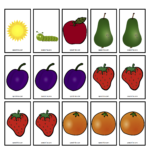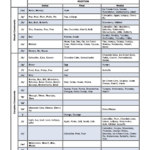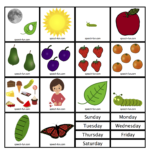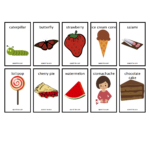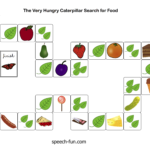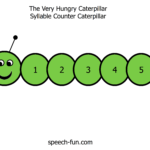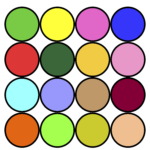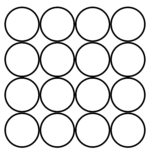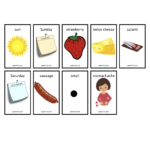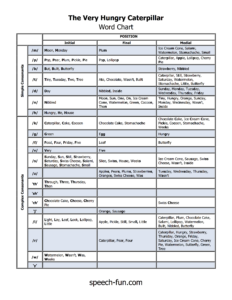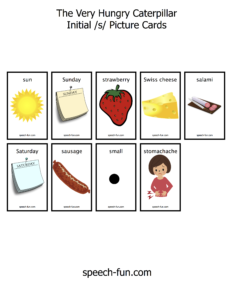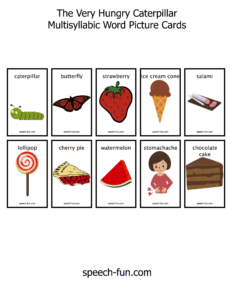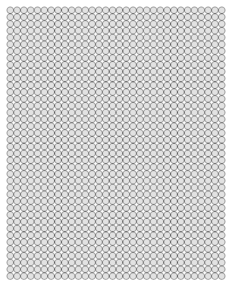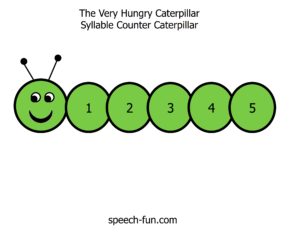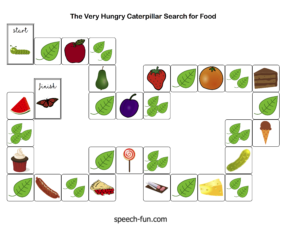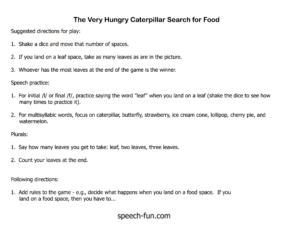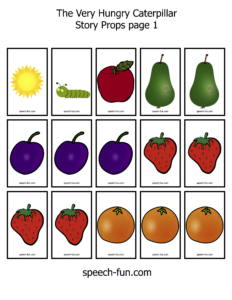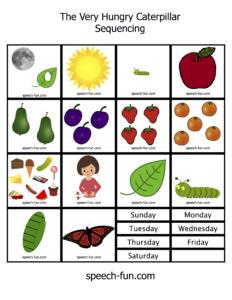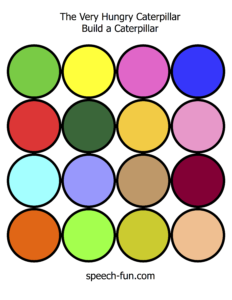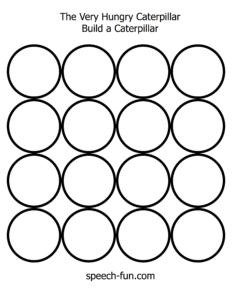Updated on September 21, 2018
Speech Kids Calgary
a multi-sensory approach to speech, language, social communication, and literacy
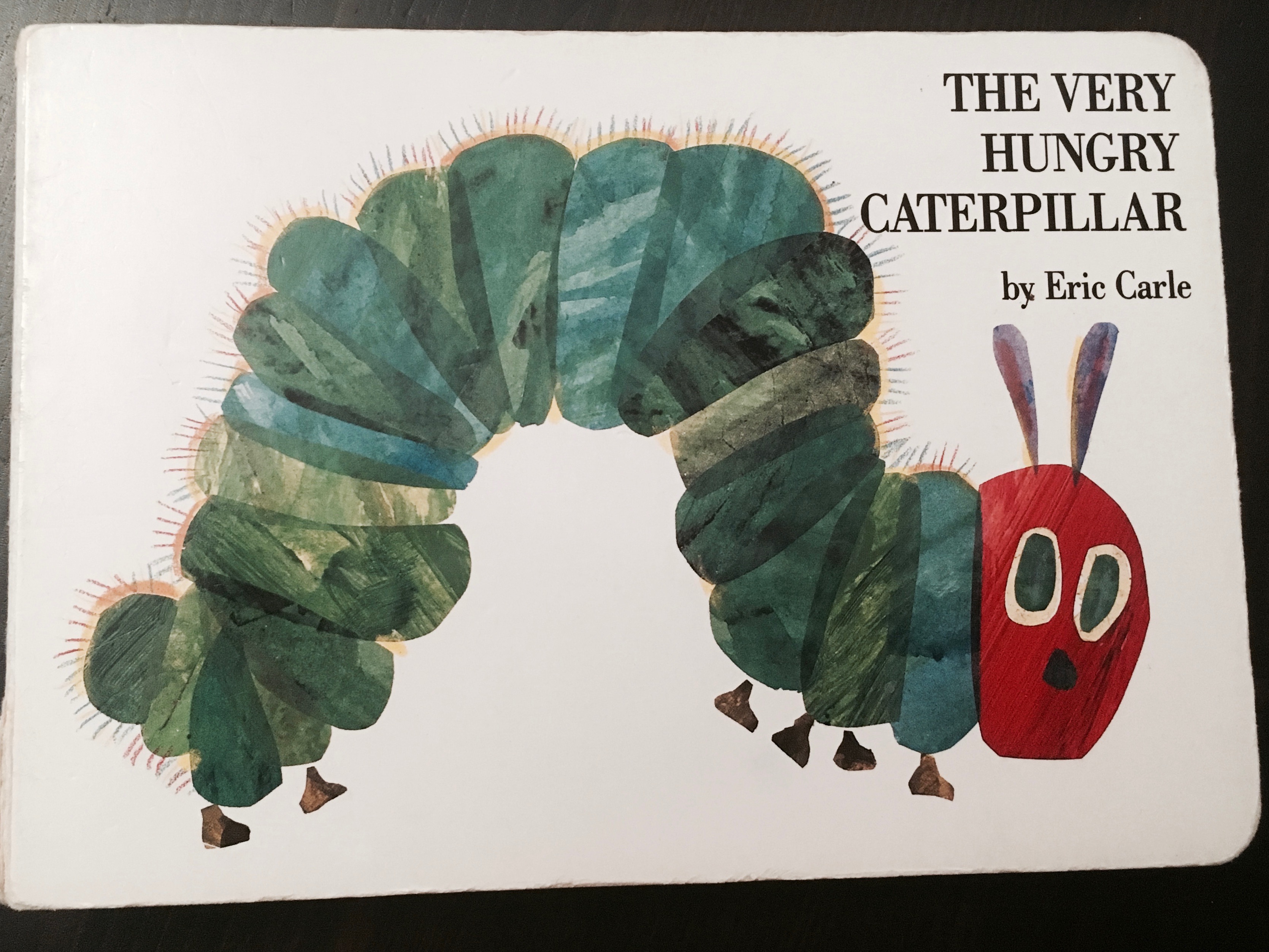
The Very Hungry Caterpillar by Eric Carle is one of my favourite preschool books. This story is popular with both kids and adults and is one of my go-to therapy tools. Besides the illustrations, I love using this story for sequencing and retelling activities! Kids love when I bring out story props and the activity becomes hands-on!
Speech Activities:
While The Very Hungry Caterpillar is a more obvious language and literacy tool, it has great potential for working on speech sounds or articulation.
- You can find target words on the The Very Hungry Caterpillar speech chart.
- Use the The Very Hungry Caterpillar game board to target /l/, /f/, and multisyllabic words (find the directions here).
- Use the multisyllabic words cards (if you print two copies you can play go fish or memory – print this on the back of each page) and the caterpillar syllable counter to work on multisyllabic words.
- Play go fish or memory with these initial /s/ cards (print two copies and print this on the back of each page).
- While sequencing or retelling the story (you can use the story props as visuals), have your child think about their target sound.
Language Activities:
Vocabulary
- Concepts –
- the story uses the following sequencing concepts: if, then, and when
- use the story props and sequencing pictures to retell the story, and focus on using sequencing concepts (first, then, next, when, after, last, etc.)
- Describing – the beautiful illustrations in this story provide many opportunities for describing.
- Comparing and contrasting – compare and contrast the food (use the story props as visuals). Talk about how two foods are the same and how they are different (e.g., strawberry and apple: both are red and fruit; strawberry is soft, apple is crunchy).
- Categories – try sorting the food from the story props into categories
- Fancy Words – grow your child’s vocabulary while using some of these related words:
- chrysalis
- wiggle
- metamorphosis
- larva
- hatch
- pupa
- emerge
Grammar
- Plurals – use this Very Hungry Caterpillar game board to collect 1 leaf, 2 leaves, or 3 leaves. (Here are the directions.)
- Pronouns – lots of repetition of “he” (referring to the caterpillar)
- Prepositions – this story uses “on”, “out”, “through” (lots of repetition of through when talking about the food he ate), and “inside”
- Verbs – The Very Hungry Caterpillar is a great story for past tense verbs. It uses many irregular past tense verbs (lay, came, ate, was, felt, built) and some regular past tense verbs (started, called, stayed).
- Conjunctions – The Very Hungry Caterpillar has a number of repetitions using the conjunction, “but”.
Following Directions
- Play Simon Says using the story props (Simon Says put the caterpillar under the table. Simon Says put two pears beside the chair.)
- Use the game board (here are the directions) to practice if…then directions
- Use the build a caterpillar activity to practice following directions (either the colour version or the black and white version). Draw a face on the green circle. Put/Glue the yellow circle beside the green circle. After you add the red circle, add the blue circle. Colour the first circle purple and the second circle yellow.
Early Literacy Activities:
- Phonological awareness –
- Rhyming – try using Willoughby Wallaby using the story prop visuals. Willoughby Wallaby waberry, an elephant sat on a…strawberry. Willoughby Wallaby wausage, an elephant sat on a…sausage.
- Sound identification – choose a sound to target (e.g., /k/) and emphasize this every time you hear a word starting with it while reading the story (e.g., c-c-caterpillar, c-c-came, c-c-cake, c-c-cream, c-c-cupcake, c-c-cocoon). To make the sound stand out even more, try adding a sound action (e.g., crash hands together for the /k/ sound).
- Story telling –
- Use the story props to help tell and retell the story.
- Try acting out the story.
Printables:
Game Board and Directions
Story Props
Sequencing Cards
Build a Caterpillar
Where to buy:
SaveSave
